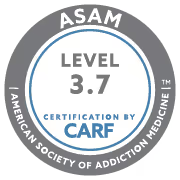Table of Contents
Pink cocaine is a synthetic party drug that mimics the appearance of cocaine but contains a dangerous mix of chemicals, often including the hallucinogen 2C-B and various synthetic stimulants. It is typically sold in powder or pill form and dyed bright pink to resemble a novelty substance. Despite its flashy look, pink cocaine poses severe health risks due to its unpredictable composition.

What Is Pink Cocaine Made Of?
Pink cocaine is not a single substance. It is a blend of psychoactive compounds, most notably 2C-B (4-bromo-2,5-dimethoxyphenethylamine), which is a synthetic hallucinogen classified as a Schedule I drug in the U.S. In many cases, dealers cut pink cocaine with MDMA, ketamine, caffeine, or even methamphetamine to amplify effects or reduce production costs.
Each batch can vary significantly in potency, which makes dosing highly dangerous. A user who previously tolerated a low-dose version may accidentally ingest a lethal amount the next time they try it.
Why Is It Called “Pink Cocaine”?
The nickname “pink cocaine” is misleading. The drug contains no cocaine and does not act like it pharmacologically. The name is likely a marketing tactic to make the drug more appealing to partygoers and club attendees, especially younger users. Its vibrant color, often associated with fun or energy, masks the serious risks it poses.
What Are the Effects of Pink Cocaine?
Pink cocaine affects the brain’s serotonin and dopamine systems, leading to a combination of stimulant and hallucinogenic effects. Common short-term effects include:
- Euphoria
- Increased energy
- Visual and auditory hallucinations
- Enhanced sensory perception
- Elevated heart rate
- Agitation or paranoia
These effects can last anywhere from 4 to 8 hours, depending on the dose and combination of substances.
What Are the Dangers of Pink Cocaine?

The primary danger of pink cocaine is its unpredictable composition. Users never truly know what they are taking, which increases the risk of overdose or adverse reactions. Specific dangers include:
- Cardiovascular stress: Rapid heartbeat, high blood pressure, and arrhythmias.
- Psychiatric episodes: Anxiety, paranoia, or psychosis can occur during or after use.
- Seizures or tremors: Resulting from overstimulation of the central nervous system.
- Overdose: A real risk due to variable potency, especially when mixed with other drugs.
In some cases, users have required hospitalization or emergency intervention due to extreme physical or mental reactions. Because pink cocaine is unregulated and manufactured illegally, there are no controls on quality or dosage.
Is Pink Cocaine Addictive?
While 2C-B itself is not considered physically addictive, the stimulant additives often used in pink cocaine, such as methamphetamine or MDMA, carry a high potential for psychological dependence. Repeated use can lead to compulsive behavior, tolerance, and withdrawal symptoms such as depression or fatigue. Those experiencing addiction should seek a cocaine addiction treatment program.
How Widespread Is Pink Cocaine Use?
Pink cocaine has seen growing popularity at raves, clubs, and music festivals across Latin America, Europe, and increasingly, the United States. Because it is a novelty drug, it often attracts first-time users who are unaware of its risks. Its popularity is amplified through social media where it is glamorized as a “fun” or “luxury” drug.
Legal Status of Pink Cocaine in the U.S.
In the United States, many of the active components in pink cocaine, including 2C-B and synthetic cathinones, are classified as Schedule I substances under the Controlled Substances Act. This makes the manufacture, distribution, or possession of pink cocaine illegal. Despite this, law enforcement continues to seize pink cocaine at parties and festivals nationwide.
What to Do If Someone Overdoses on Pink Cocaine

If someone shows signs of overdose, such as seizures, hallucinations, trouble breathing, or loss of consciousness, call 911 immediately. Do not assume the drug will “wear off.” Medical professionals can administer treatments such as sedatives, IV fluids, or other interventions to stabilize the person.
If the person is conscious, try to keep them calm and still until help arrives. If unconscious, place them in the recovery position to prevent choking and monitor their breathing.
Important Resources
What Is Narcan and How Does It Save Lives?
Narcan, also known as naloxone, is a medication used to reverse opioid overdoses. While it is not effective against pink cocaine specifically, it is a critical tool in the fight against fentanyl-laced substances. Learn more in our article: What Is Narcan and How Does It Save Lives?
How Is Cocaine Made and Why Is It So Addictive?
Although pink cocaine does not contain actual cocaine, its name may mislead users into thinking it has similar effects. Understand the real risks by exploring: How Is Cocaine Made and Why Is It So Addictive?












